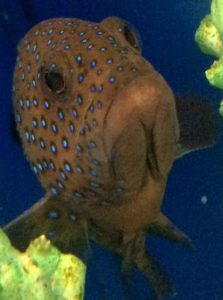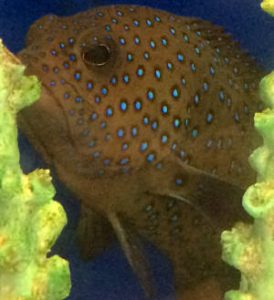
Cephalopholis formosa
.
| Difficulty | Medium |
| Minimum Tank Size | 150 Gallons |
| Diet | Carnivore |
| Water Parameters | 72-78 F, pH 8-8.4, Salinity 1.020-1.025 |
| Aggression | Aggressive |
| Size | 13" |
The Blue Line Grouper is a fairly large, highly aggressive fish. Often seen as the Oscar of the sea, groupers will fight with any fish they don’t like and require a large tank to help curve their aggression.
Combine their aggression with their carnivorous diet and you have a fish that is difficult to keep with others. Ensure you only keep large, aggressive fish who cannot be taken down without a fight.

The Blue Line Grouper can be seen spending a lot of its time behind rocks and corals. This keeps them safe from other predators while also giving them an easy ambush spot to catch other fish. Even large tangs may become skittish when the Blue Line Grouper is sitting around the corner.
When setting up your tank it’s important to keep in mind their strength. The Blue Line Grouper is a thick, strong fish who can easily kick around decorations or unstable live rocks.
Behavior & Aggression
The Blue Line Grouper is over a foot long and quite thick. Using its heavy body the grouper can fight nearly every marine fish. Thankfully fish will not fight each other if the opponent will fight back unless there is a lack of space. If you do plan on keeping the Blue Line Grouper with multiple large, aggressive fish you will need a larger tank of 200+ gallons. When kept alone or with one other fish a smaller tank can suffice.
Groupers love to swim to different spots of the tank and stay there. While swimming in place they will look for food, keep an eye on their tank mates as well as watch any near by humans.
It is possible to house the Blue Line Grouper in a much smaller tank when juvenile, however you must upgrade the tank within a year. These fish grow fast, and as they do so does their aggression. It is better to move the grouper sooner rather than later, less he attack someone else due to too little territory.
When selecting tank mates it is essential to think of a few things:
- What size will both fish end up?
- How big are the fish currently?
- Which fish should be added first?
- How many homes can the tank have?
The last note is huge. When designing your tank you will want the width to be no less than two feet, giving the fish ample space to turn around. Additionally try to make as many caves and overhangs as possible. This will create significantly more territories, which will decrease aggression. The more hidden the fishes home, the less shy they will need to be when swimming freely.
Note: Never keep two of the same groupers together in a tank. These fish, while often calm towards other species, will not stand for another of their kind in a small environment. Unless your tank is absolutely massive do not try and own two of a kind.
Diet & Feeding
The Blue Line Grouper is a predator and will always feed as one. This means live foods are always accepted. The will also accept prepared foods, however I highly recommend sinking foods. Surface bound foods are easy enough for the grouper to eat, however they will quickly strike at the food. This, while interesting to see, makes a huge mess and can splash water several feet from the tank.
Thawed fish may be used in place of live feeder fish. Remember to balance out their diet with a different meats as well as whole body foods. This means foods with the bones and organs still inside, not prepared for human consumption. A common choice here is frozen silver sides or frozen cubes, however feeder fish can be used as well.
A food to avoid is krill. While this will get picky eaters to eat, it may spoil them into only accepting krill. This is a big issue, as krill is not a highly nutritious food. I would recommend skipping out on it entirely.
The Blue Line Grouper hunts by sight, meaning he cannot eat what he cannot see. This is the primary issue with frozen foods, however getting their attention o having other fish feeding will usually be enough for them to find the foods. If your grouper lives alone you may have no resort to live foods or moving the frozen fish around until they notice it.
If your fish rarely notices food in their tank try feeding with a skewer. This makes moving the food easy and will create an association with the skewer. Every time the fish sees it enter the tank they will enter feeding mode. Just be sure your skewer is not so sharp that it will harm your grouper.
the Blue Line Grouper should be fed every two days or so. As they eat large foods aggressively, they will often need extra time to digest and will not over eat. If you see your grouper swimming around the tank not looking at any passing humans, he is likely hungry.